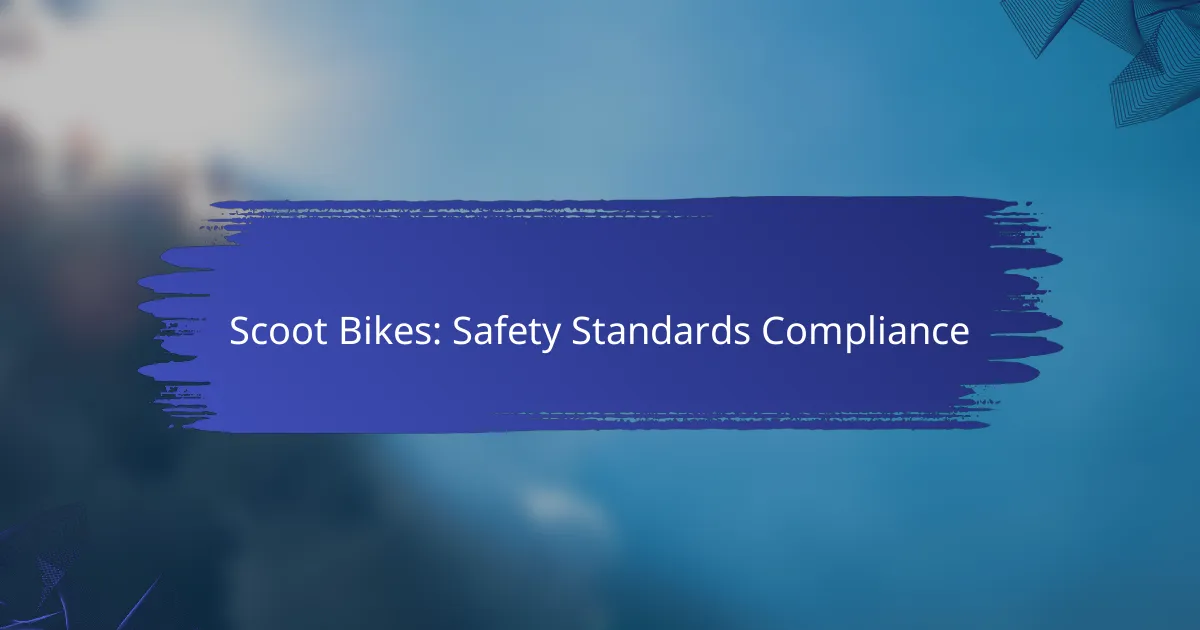Scoot Bikes in the UK are required to meet stringent safety standards, including ISO 4210, EN 14764, and CE marking, to ensure both user safety and product reliability. These standards address various aspects of bike safety and performance, helping to minimize risks associated with riding. Compliance is essential not only for rider protection but also to avoid potential legal liabilities and enhance the overall riding experience.

What are the safety standards for Scoot Bikes in the UK?
Scoot Bikes in the UK must comply with specific safety standards to ensure user safety and product reliability. Key standards include ISO 4210, EN 14764, and CE marking requirements, each addressing different aspects of bike safety and performance.
ISO 4210 compliance
ISO 4210 is an international standard that outlines safety requirements for bicycles, including Scoot Bikes. It covers various aspects such as braking performance, frame strength, and overall durability.
Manufacturers must ensure that their Scoot Bikes meet these standards through rigorous testing. This includes checks on components like brakes and tires to confirm they can withstand typical usage conditions.
EN 14764 standards
EN 14764 is a European standard specifically for city and trekking bicycles, which applies to Scoot Bikes designed for urban environments. This standard focuses on safety features, including lighting, reflectors, and the overall stability of the bike.
Compliance with EN 14764 ensures that Scoot Bikes are equipped with necessary safety features, making them suitable for everyday use in busy areas. Manufacturers must regularly test their products to meet these evolving standards.
CE marking requirements
CE marking indicates that a Scoot Bike meets EU safety, health, and environmental protection standards. This marking is mandatory for all bikes sold in the UK and signifies compliance with relevant directives.
To obtain CE marking, manufacturers must conduct a conformity assessment, ensuring their products meet all applicable safety standards. This process often involves third-party testing to validate the bike’s safety features and performance metrics.

How do Scoot Bikes ensure rider safety?
Scoot Bikes prioritize rider safety through a combination of built-in safety features and regular maintenance checks. These measures are designed to minimize risks and enhance the overall riding experience.
Built-in safety features
Scoot Bikes are equipped with various built-in safety features that enhance rider protection. These include bright LED lights for visibility, reflective surfaces for increased awareness, and robust braking systems that ensure quick stops.
Additionally, many models come with stability control systems that help maintain balance, especially during turns or sudden stops. Riders should familiarize themselves with these features to maximize their safety while riding.
Regular maintenance checks
Regular maintenance checks are crucial for ensuring that Scoot Bikes remain safe to ride. These checks typically include inspections of the brakes, tires, and electrical systems to identify any potential issues before they become serious problems.
Riders should adhere to a maintenance schedule, which may vary by model but generally suggests checks every few weeks or after a set number of rides. Keeping the bike in good condition not only enhances safety but also prolongs its lifespan.

What are the risks of non-compliance with safety standards?
Non-compliance with safety standards for scoot bikes can lead to serious risks, including higher accident rates and potential legal liabilities. Adhering to established safety regulations is crucial for ensuring rider safety and minimizing risks associated with scoot bike usage.
Increased accident rates
When scoot bikes do not meet safety standards, the likelihood of accidents increases significantly. Poorly designed or manufactured bikes may lack essential features like effective braking systems or proper lighting, which can lead to collisions or falls.
For example, a scoot bike without adequate reflectors or lights may be difficult to see at night, increasing the risk of nighttime accidents. Riders should always check that their bikes comply with safety regulations to ensure a safer riding experience.
Legal liabilities
Non-compliance with safety standards can expose manufacturers and riders to legal liabilities. If an accident occurs due to a safety defect, affected parties may pursue legal action against the manufacturer or the rider, leading to costly lawsuits and settlements.
In many jurisdictions, manufacturers are required to adhere to specific safety regulations. Failure to comply can result in fines and penalties, further emphasizing the importance of maintaining safety standards in the production and use of scoot bikes.

How can consumers verify Scoot Bike safety compliance?
Consumers can verify Scoot Bike safety compliance by checking for certification labels and reviewing manufacturer documentation. These steps ensure that the bikes meet established safety standards and regulations.
Checking certification labels
Certification labels are crucial indicators of a Scoot Bike’s safety compliance. Look for labels from recognized organizations, such as the Consumer Product Safety Commission (CPSC) or the European Committee for Standardization (CEN), which signify that the bike meets specific safety requirements.
When examining the label, ensure it is intact and clearly displayed on the bike. If the label is missing or damaged, it may indicate potential safety issues. Always verify the certification against the manufacturer’s claims to ensure authenticity.
Reviewing manufacturer documentation
Manufacturer documentation provides detailed information about the safety features and compliance of Scoot Bikes. This includes user manuals, safety data sheets, and warranty information that outline the bike’s specifications and safety testing results.
Check the manufacturer’s website for downloadable documents or contact customer service for assistance. Ensure that the documentation references relevant safety standards and includes any certifications obtained during testing. This can help you make an informed decision about the bike’s safety compliance.

What are the best practices for Scoot Bike safety?
Best practices for Scoot Bike safety include regular maintenance checks and proper helmet usage. Adhering to these practices can significantly reduce the risk of accidents and injuries while riding.
Regular safety inspections
Conducting regular safety inspections is crucial for ensuring that your Scoot Bike operates safely. Check the brakes, tires, lights, and steering components at least once a month or before long rides. This proactive approach helps identify potential issues before they become serious problems.
During inspections, look for wear and tear on the tires and ensure that the brakes respond effectively. Keeping a checklist can help streamline this process and ensure no critical areas are overlooked. For example, you might include checking the battery, ensuring the lights are functional, and verifying that all screws and bolts are tightened.
Proper helmet usage
Wearing a helmet is a fundamental aspect of Scoot Bike safety. A properly fitted helmet can reduce the risk of head injuries by a significant margin during an accident. Always choose a helmet that meets safety standards, such as those set by the CPSC in the United States or the EN 1078 in Europe.
When wearing a helmet, ensure it sits level on your head and is snug but comfortable. The straps should form a V shape under your ears and be adjusted so that the helmet does not move when you shake your head. Remember to replace your helmet after any significant impact, as it may no longer provide adequate protection.

What regulations govern Scoot Bike safety in major cities?
Scoot Bike safety is primarily governed by local regulations that vary by city, focusing on rider protection, vehicle standards, and operational guidelines. Major cities often implement specific rules to ensure safe riding practices and reduce accidents.
London cycling regulations
In London, the use of Scoot Bikes falls under the Transport for London (TfL) regulations, which require all riders to wear helmets and adhere to traffic laws. Riders must also ensure their bikes are equipped with lights and reflectors for visibility, especially during low-light conditions.
Additionally, the London Cycling Design Standards outline requirements for bike lanes and infrastructure that enhance safety for all cyclists. Riders should familiarize themselves with these standards to navigate the city safely.
Manchester safety guidelines
Manchester has implemented its own set of safety guidelines for Scoot Bikes, emphasizing the importance of wearing helmets and using designated bike lanes whenever possible. Local authorities encourage riders to complete safety training programs to improve their riding skills and awareness of road conditions.
The city also promotes regular maintenance checks for Scoot Bikes, ensuring that brakes, tires, and lights are functioning properly. Riders should conduct these checks before each ride to minimize the risk of accidents.

How do Scoot Bikes compare to other electric bikes in safety?
Scoot Bikes generally meet or exceed safety standards compared to other electric bikes, focusing on stability, braking systems, and visibility. Their design incorporates features that enhance rider safety, making them a reliable choice for urban commuting.
Comparison with Bird scooters
When comparing Scoot Bikes to Bird scooters, Scoot Bikes often have superior stability due to their larger wheels and wider frames. This design helps reduce the risk of tipping over, especially on uneven surfaces. Additionally, Scoot Bikes typically feature enhanced braking systems that provide better stopping power in various conditions.
Bird scooters, while popular, may lack some of the safety features found in Scoot Bikes, such as integrated lights and reflective surfaces. Riders should consider these factors when choosing between the two options, especially for nighttime use.
Comparison with Lime scooters
Scoot Bikes offer a more robust safety profile compared to Lime scooters, particularly in terms of rider visibility and comfort. The larger frame and ergonomic design of Scoot Bikes contribute to a more stable ride, which can be crucial for new riders or those navigating busy streets.
Lime scooters, while efficient for short trips, often have smaller wheels and less effective braking systems. Riders should be aware of these differences, as they can impact overall safety, particularly in urban environments where quick stops may be necessary.

What future trends are emerging in Scoot Bike safety standards?
Future trends in Scoot Bike safety standards focus on enhanced technology integration, stricter regulatory frameworks, and increased user awareness. Innovations such as advanced braking systems and real-time monitoring are becoming more common, while governments are tightening safety regulations to ensure rider protection.
Technological advancements in safety features
Technological advancements are significantly shaping the safety features of Scoot Bikes. Features like automatic braking, collision detection systems, and integrated GPS tracking are becoming standard. These innovations not only enhance rider safety but also provide valuable data for manufacturers to improve designs.
Regulatory changes and compliance requirements
Regulatory changes are increasingly influencing Scoot Bike safety standards. Many regions are implementing stricter compliance requirements, which may include mandatory safety certifications and regular inspections. Riders should stay informed about local regulations to ensure their Scoot Bikes meet the necessary safety criteria.
User education and awareness initiatives
User education plays a crucial role in promoting safety among Scoot Bike riders. Awareness initiatives, such as safety workshops and online resources, are being developed to inform users about best practices and safe riding techniques. Engaging in these programs can significantly reduce accidents and enhance overall safety on the roads.










